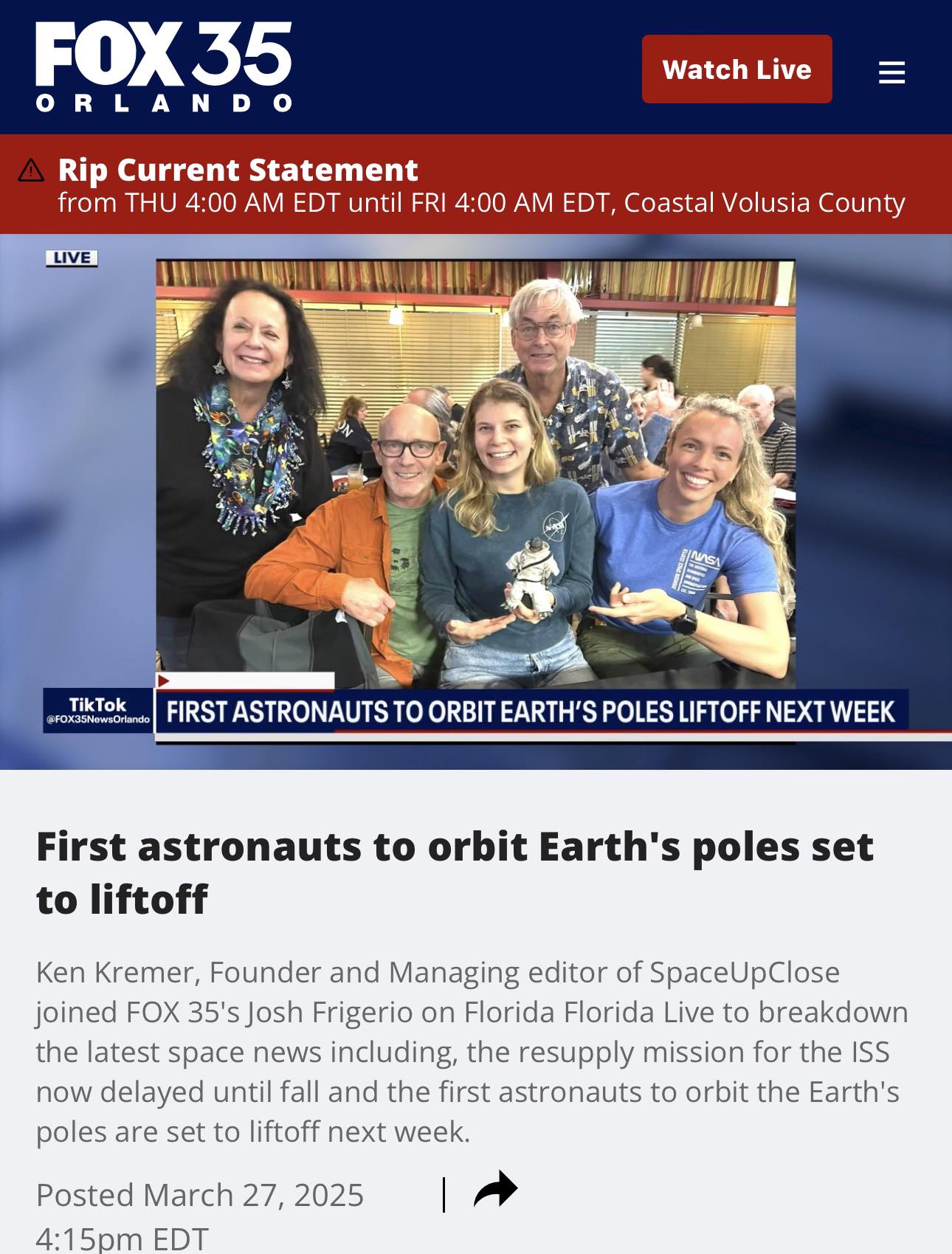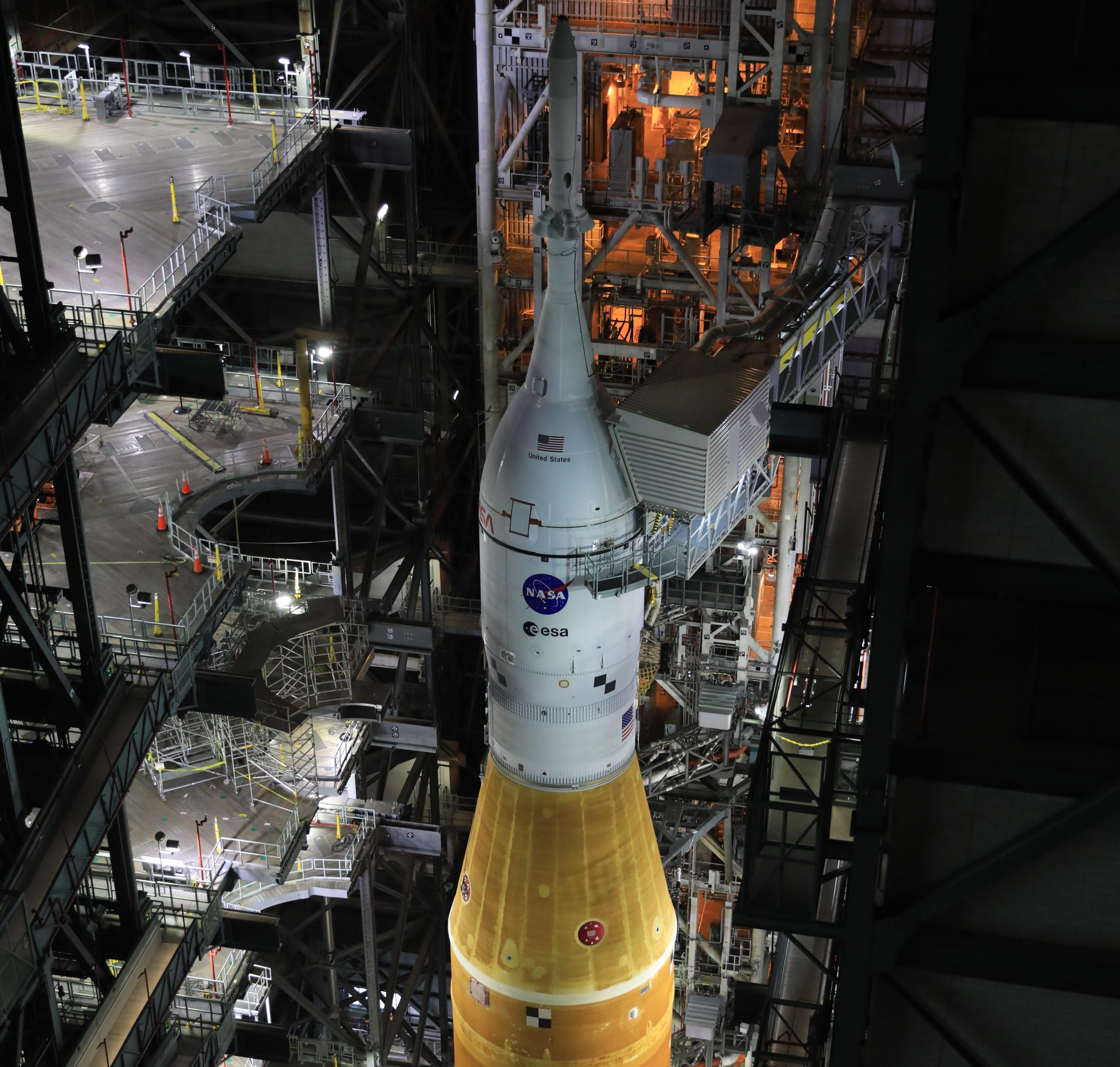
For SpaceUpClose.com & RocketSTEM
KENNEDY SPACE CENTER, FL – NASA announced that the agency’s Space Launch System (SLS) Mega Moon rocket is ready for its maiden rollout to the launch pad at the Kennedy Space Center (KSC) later this week to carry out a critical fueling test of the 322 foot tall vehicle in early April which will pave the way to launch on the unpiloted Artemis 1 lunar mission as soon as June – if all goes well.
The SLS moon rocket integrated with the Orion deep space human rated capsule will roll out from the Vehicle Assembly Building (VAB) with first motion at approximately 5 PM EDT (2100 GMT) Thursday, March 17 – and should arrive at historic Launch Complex 39B at KSC about 11 hours later.
“We are in very good shape and ready to proceed with this roll on Thursday evening,” Charlie Blackwell-Thompson, Artemis launch director at NASA, said at the Monday, March 14 media briefing.
“It will be a breathtaking sight! It’s gonna be amazing!”
The weather forecast looks favorable at this time – although severe weather is expected in the Space Coast region on Tuesday and Wednesday that is currently expected to clear in time for rollout late Thursday afternoon.
In anticipation of the March 17 rollout technicians with NASA and Jacobs have been methodically retracting the work platforms surrounding SLS one by one inside High Bay 3 inside the VAB.
“Our Moon rocket will roll out of the Vehicle Assembly Building at @NASAKennedy this Thursday for wet dress rehearsal. Teams with @NASAGroundSys and Jacobs have continued retracting the platforms one by one. Now, only two more platforms remain surrounding the SLS!” NASA tweeted.
Our Moon rocket will roll out of the Vehicle Assembly Building at @NASAKennedy this Thursday for wet dress rehearsal. Teams with @NASAGroundSys and Jacobs have continued retracting the platforms one by one. Now, only two more platforms remain surrounding the SLS! pic.twitter.com/u5x8tjy3jY
— NASA_SLS (@NASA_SLS) March 14, 2022
The combined stack of SLS, Orion, Mobile Launcher and Crawler-Transporter-2 weighing some 21 million pounds will make two stops along the way and collect important engineering data.
“NASA’s Space Launch System rocket and @NASA_Orion are ready to usher in a new chapter of exploration. Soon we will roll out this mega Moon rocket to the launch pad for the first time. We are going,” NASA tweeted with this video.
NASA’s Space Launch System rocket and @NASA_Orion are ready to usher in a new chapter of exploration. Soon we will roll out this mega Moon rocket to the launch pad for the first time.
We are going. 🚀 pic.twitter.com/lBQ5fUSeSq
— NASA_SLS (@NASA_SLS) March 14, 2022
The upgraded crawler-transporter-2 (CT-2) originally built for NASA’s Apollo Moon landing program in the 1960s and 1970s will move the stack at a maximum of 0.8 mph
Once SLS is safely secured hard down at Launch Complex 39B at the Kennedy Space Center engineers and technicians have about two weeks of intensive work to prepare the rocket for its critical fueling test known as the Wet Dress Rehearsal (WDR).
 Fully stacked NASA Space Launch System (SLS) rocket for Artemis 1 Moon mission stands on top of mobile launcher, with core stage mounted in between the twin solid rocket boosters, inside High Bay 3 of the Vehicle Assembly Building (VAB) at NASA’s Kennedy Space Center in Florida in Dec. 2021 ahead of launch slated for Spring 2022. Credit: Ken Kremer/spaceupclose.com
Fully stacked NASA Space Launch System (SLS) rocket for Artemis 1 Moon mission stands on top of mobile launcher, with core stage mounted in between the twin solid rocket boosters, inside High Bay 3 of the Vehicle Assembly Building (VAB) at NASA’s Kennedy Space Center in Florida in Dec. 2021 ahead of launch slated for Spring 2022. Credit: Ken Kremer/spaceupclose.com
“At the pad, NASA will conduct a final prelaunch test known as wet dress rehearsal, which includes loading the SLS propellant tanks and conducting a launch countdown,” said NASA.
“The rollout involves a 4-mile (6.4 km) journey between the Vehicle Assembly Building and the launch pad, expected to take between six and 12 hours.”
The WDR is currently targeted for April 3. The call to stations is expected on April 1.
Both stages of SLS will be fueled during the WDR.
The propellant loading is expected to last about eight hours or so, said Charlie Blackwell-Thompson, Artemis launch director at NASA, at the media briefing.
By comparison NASA’s Space Shuttle from which SLS is derived took about two and a half hours. SLS is longer because it has an upper stage which must also be loaded with propellants, she noted.
The first stage will be fueled with LOX and LH2 starting around 7 a.m. EDT (1100 GMT) on WDR test day.
The countdown dress rehearsel will proceed to the T Minus 10 second mark and then be intentionally aborted before engine ignition.
The Wet Dress Rehearsal (WDR) fueling test is the final major test before launch and a successful outcome is key to setting a launch target date for Artemis 1 – most likely NET June 2022.
“During the test at the launch pad, engineers will be on duty in the Launch Control Center and in other stations where they will work during the Artemis I launch. They will capture as much data as possible on the performance of all the systems that are part of SLS and the Orion spacecraft as well as the Kennedy ground systems. NASA will set a target launch date after a successful wet dress rehearsal test.”
After completing the WDR and the SLS rocket and spacecraft systems are verified the 322-foot-tall rocket will roll back into the VAB “for final inspections and checkouts, including the second part of the flight termination system test, ahead of returning to the pad for launch.”

SLS is the most powerful rocket the world has ever seen generating some 8.8 million pounds of liftoff thrust at ignition – about 15% more powerful than NASA’s legendary Saturn V that hurled the first humans to land on the Moon back in 1969 on the Apollo 11 moon landing mission.
You can watch live, static camera views of the debut and arrival at the pad which will be available starting at 4 p.m. EDT, Thursday March 17, on the Kennedy Newsroom YouTube channel.
Learn more about Artemis 1 and NASA’s new webpage:
Explore the Space Launch System rocket in this new #Artemis I webpage.
Scroll down to the clickable rocket and click on each part of the SLS to learn more about it HERE >> https://t.co/aGZCd2KG9V— NASA_SLS (@NASA_SLS) March 15, 2022
This NASA animation shows what the SLS rollout from the VAB will look like – and soon becomes reality!
This illustration will soon be a reality! In a couple of days, the SLS and @NASA_Orion will roll out of the VAB at @NASAKennedy for its final test before launch of @NASAArtemis I. Will you be watching rollout live?
Coverage info HERE >> https://t.co/bttDeMjo7Z pic.twitter.com/YCv2xpolhl
— NASA_SLS (@NASA_SLS) March 15, 2022
NASA’s iconic ‘Worm’ logo has been painted on the side of the upgraded 5 segment twin 177 foot tall Solid Rocket Boosters (SRB) that will provide most of the SLS rockets liftoff thrust.
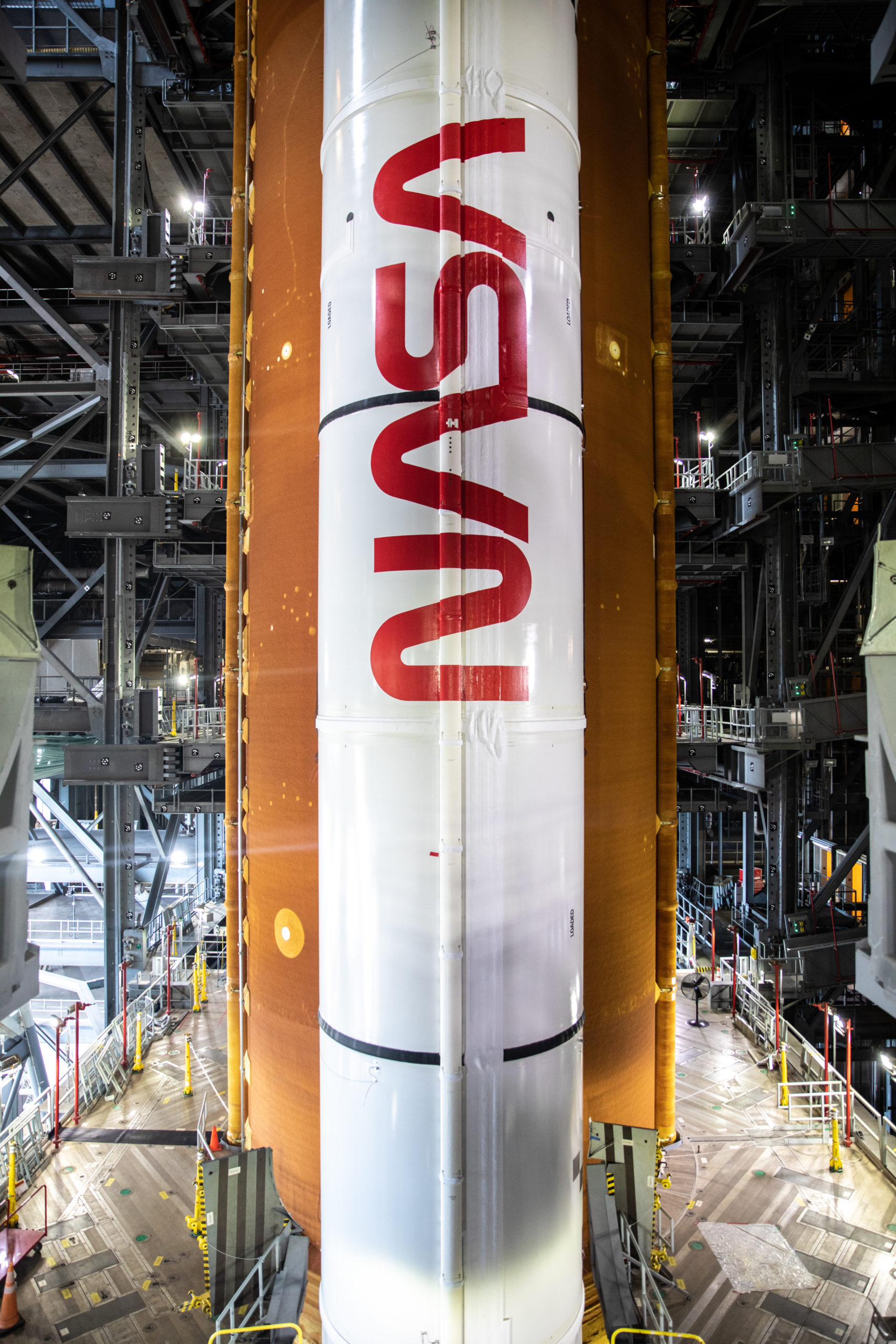
The Space UpClose team of Ken Kremer and Jean Wright will attend and witness the rollout from VAB at the KSC Press Site
Be sure to watch for our rollout photos
In the meantime enjoy our UpClose pre-rollout photos herein of SLS 1 taken inside the VAB
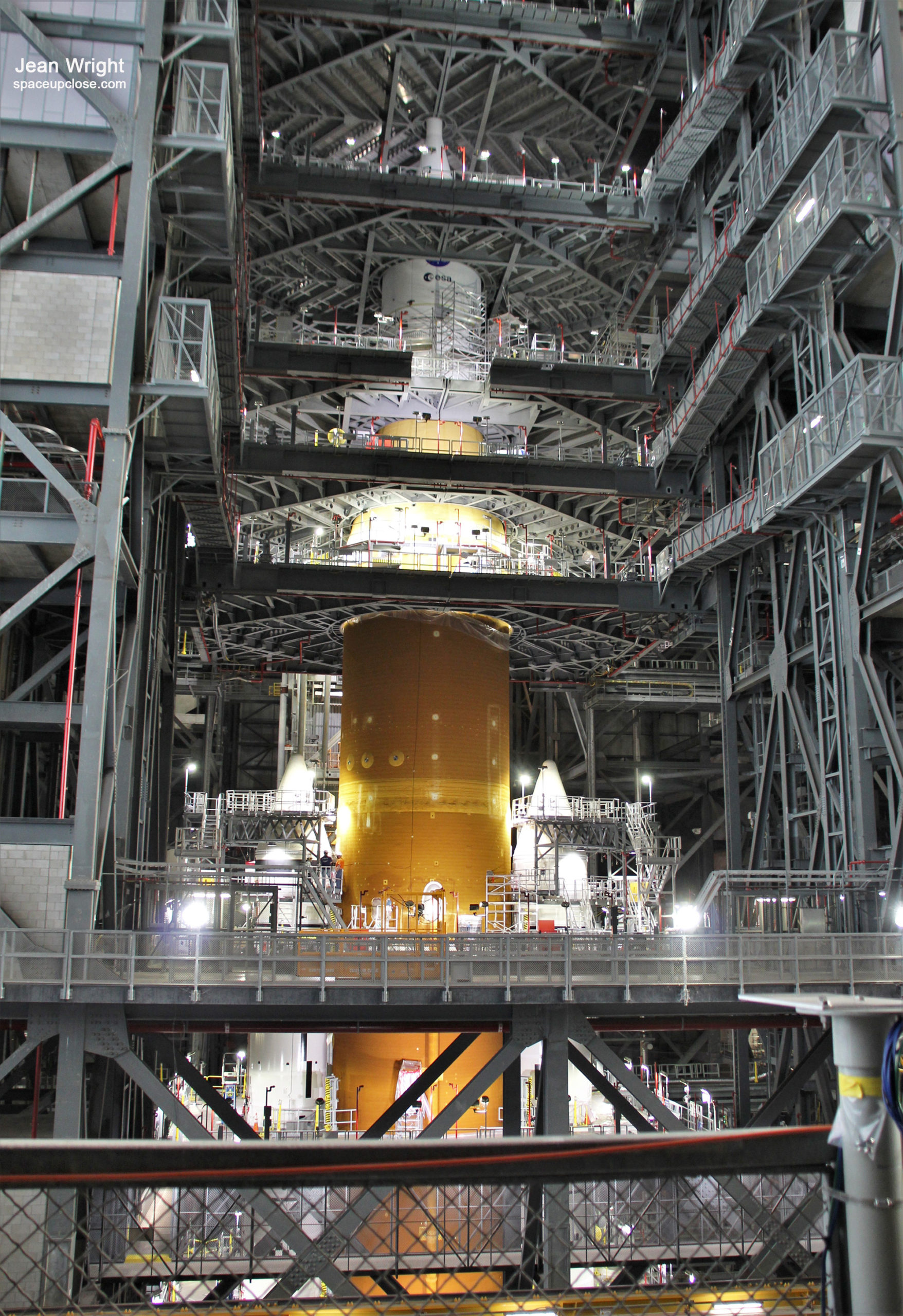
Liftoff of the uncrewed Artemis 1 mission is slated for no earlier than June 2022 from Launch Complex 39B at NASA KSC on the first in a series of increasingly complex missions to test the SLS heavy lift mega rocket and Orion crew capsule as an integrated system prior to crewed flights to the Moon starting with Artemis 2 – targeting launch in 2024.
SLS 1 will launch the Orion crew spacecraft on the Artemis 1 mission lasting about 26-days on a journey of some 280,000 miles (450,000 kilometers) from Earth to many thousands of miles past the moon and then return to Earth.
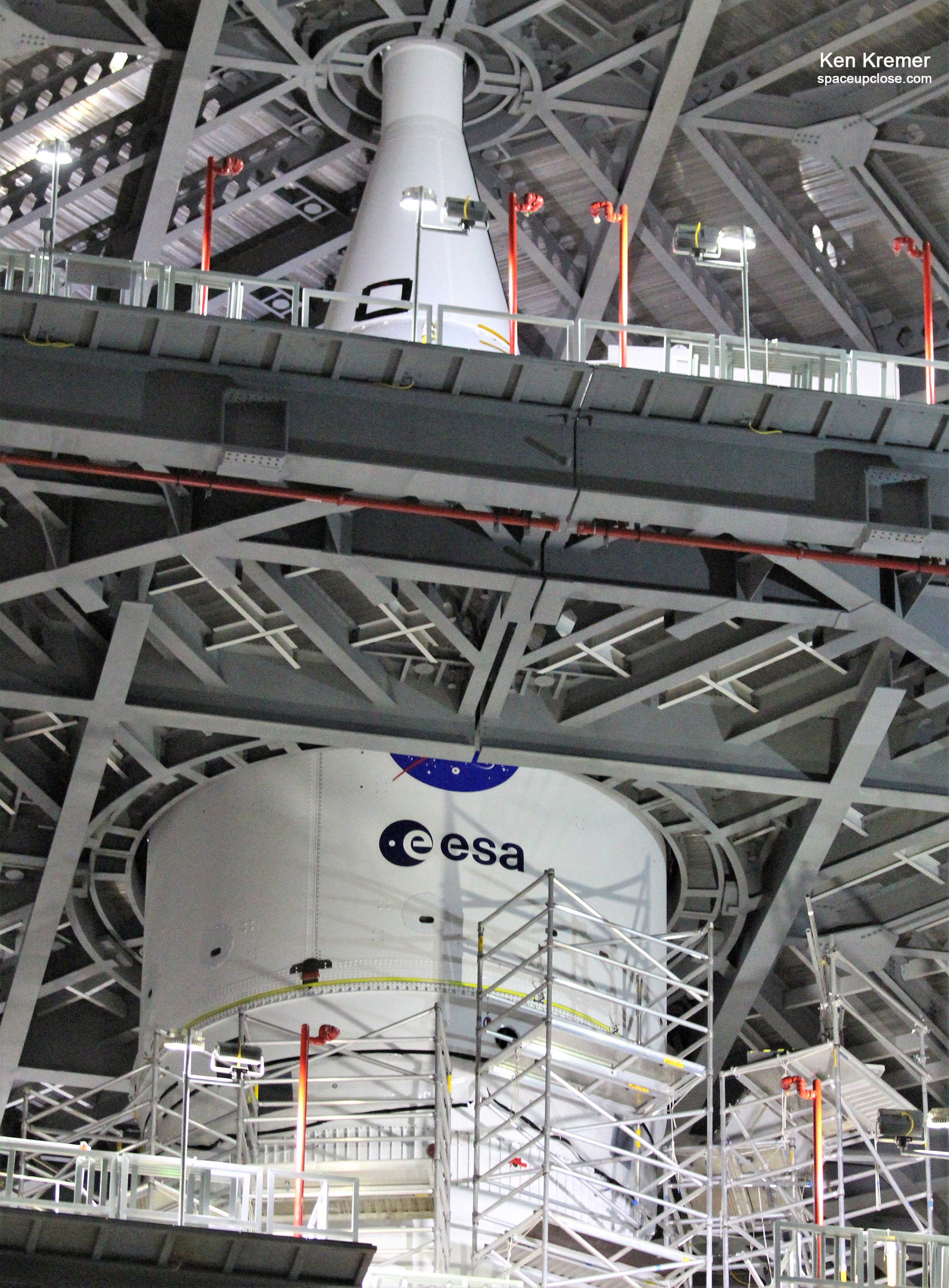
NASA will land the first woman and the first person of color on the Moon on Artemis 3 – planned for NET 2025 that will “pave the way for a long-term lunar presence and serving as a steppingstone on the way to Mars.”
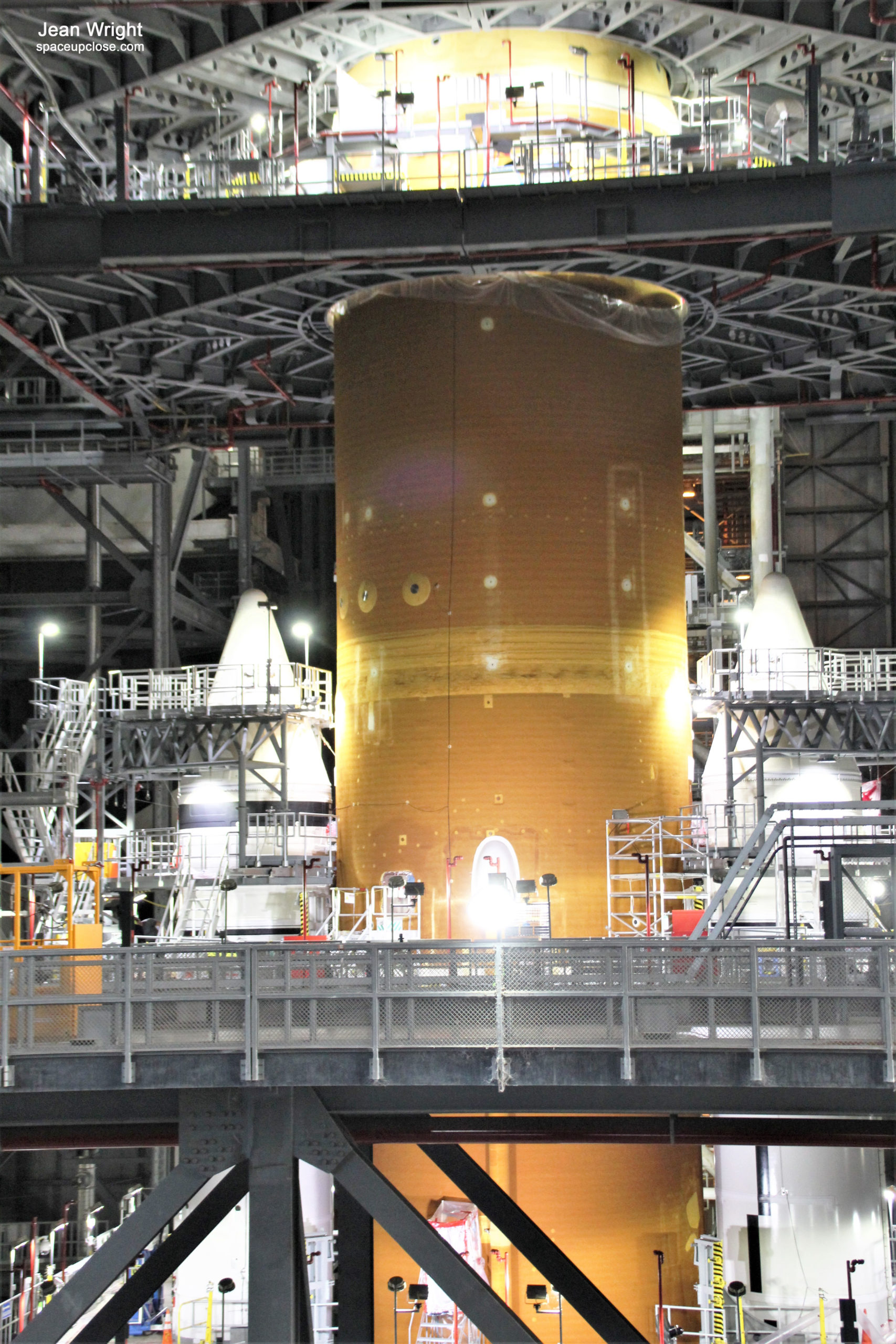
SLS serves as the backbone of the Artemis program and the nation’s future deep space exploration missions.
The SLS core stage measures 212 feet tall and 27.6 feet in diameter.
Overall SLS stands 322 feet (98 meters) tall and weighs 5.75 million pounds
It is equipped with four Aerojet-Rocketdyne built RS-25 engines fueled by over 730,000 gallons of cryogenic super cold LOX (liquid oxygen) and LH2 (liquid hydrogen) propellants to generate some 2 million pounds of liftoff thrust to help power the SLS rocket at launch.

SLS was built by prime contractor Boeing at NASA’s Michoud Assembly Facility in New Orleans.
The RS-25 engines are attached to the base of the core stage and are recycled from the Space Shuttle where they were reused and reflown numerous times.
Previously known as the Space Shuttle Main Engine, or SSME, they have been refurbished and upgraded in numerous ways including with a new ‘brain controller’ and can fire at 109% thrust.
This first SLS core stage arrived on NASA’s Pegasus barge April 27 and was then rolled off the barge and into VAB two days later on April 29 for the extensive stacking and preparatory operations for launch on the history making Artemis 1 mission to deliver NASA’s Orion deep space human rated capsule to the Moon.

WFTV Channel 9 ABC News Orlando featured Ken ‘s pre-rollout commentary about how critical NASA’s Space Launch System Artemis 1 launch to the Moon is to NASA – with 1st ever rocket rollout to pad 39B just days away at NASA’s Kennedy Space Center.

Watch Ken’s continuing reports about Artemis, SLS, Orion and NASA missions, JWST, IXPE, DART, Lucy Asteroid mission, GOES, SpaceX Cargo and Crew Dragons, SpaceX Starlink, Commercial Crew and Starliner and Crew Dragon, Blue Origin and Space Tourism, and onsite for live reporting of upcoming and recent SpaceX and ULA launches including Crew 1 & 2 & 3, ISS, Solar Orbiter, Mars 2020 Perseverance and Curiosity rovers, NRO spysats and national security missions and more at the Kennedy Space Center and Cape Canaveral Space Force Station.
Stay tuned here for Ken’s continuing Earth and Planetary science and human spaceflight news: www.kenkremer.com –www.spaceupclose.com – twitter @ken_kremer – email: ken at kenkremer.com
Dr. Kremer is a research scientist and journalist based in the KSC area, active in outreach and interviewed regularly on TV and radio about space topics.
………….
Ken’s photos are for sale and he is available for lectures and outreach events
Please consider supporting Ken’s work by purchasing his photos and/or donating at Patreon:
https://www.patreon.com/kenkremer
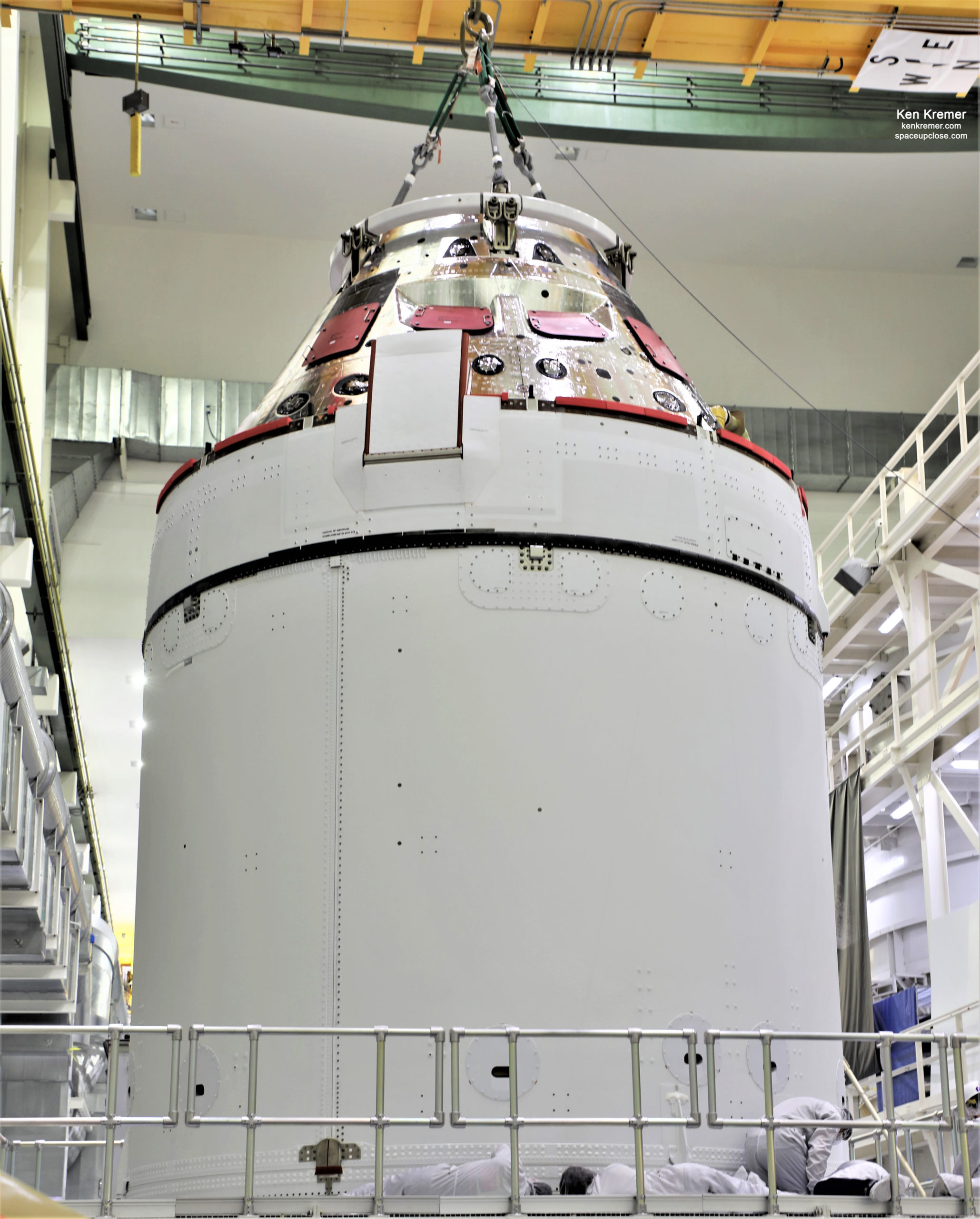
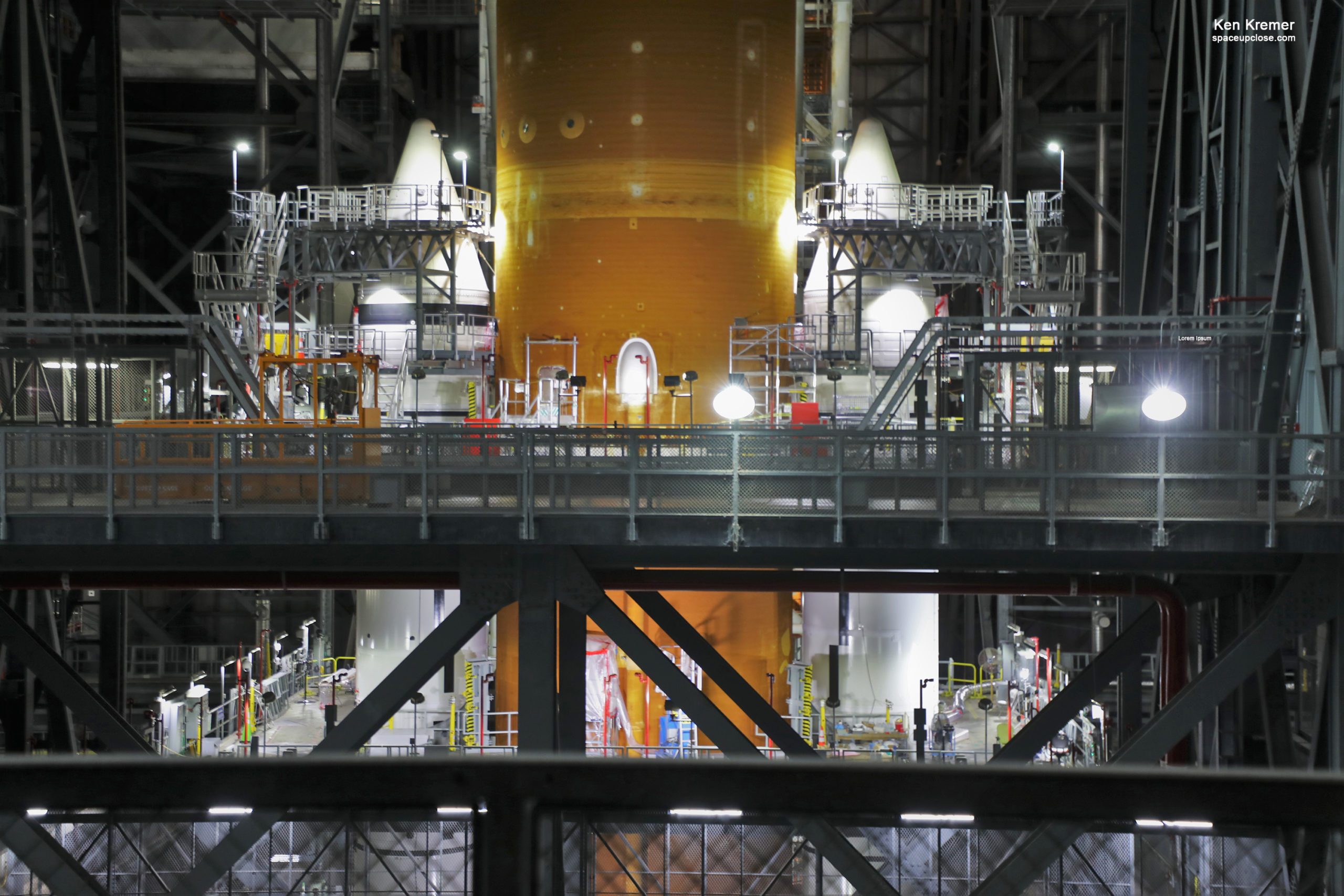

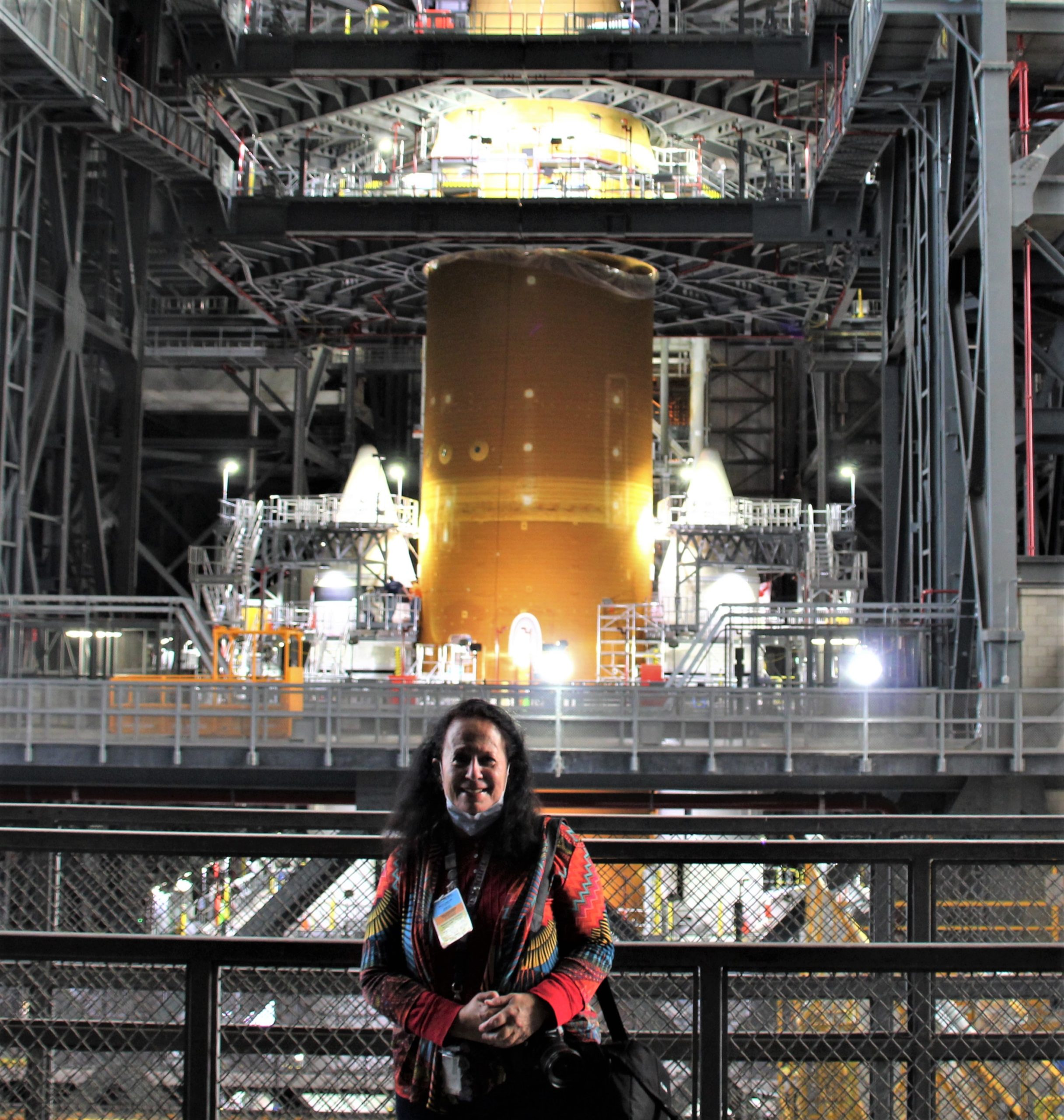

x


